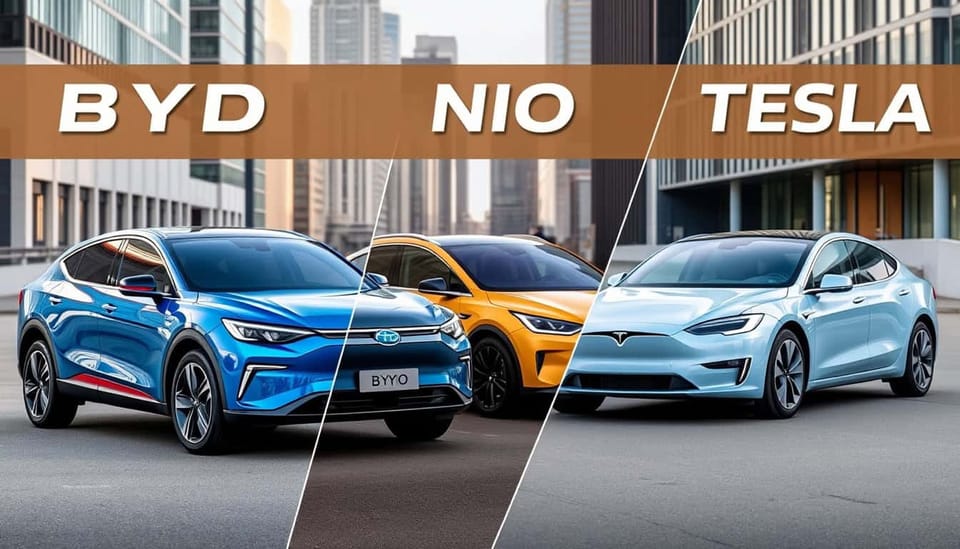How do BYD, Nio, and other Chinese EVs compare to Tesla?

The last few years have seen electrification markets undergo dramatic changes and be turned on their axis with the astounding rise of new Chinese innovative champions like BYD and Nio. It was an understatement since these are not doing mere competition with Tesla; they are busy redefining the whole landscape on the available scale of high-tech, mass, affordable cars. This article seeks to compare such dynamic Chinese brands to the current king of the best-selling vehicle in the world as of 2024—the Tesla Model Y, in terms of what makes them different and what kind of prices are being used to sell them, and what kind of technological advantages would be allowed.
Key Takeaways
-
Price Advantage: Chinese EVs are usually much cheaper compared to Teslas. This, however, favors to a reasonable extent the budget-conscious consumer looking for electric cars that offer value appreciation without forgoing much in terms of the most important features.
-
Smart features: Most of the Chinese EVs have advanced technology and connectivity that integrates advanced infotainment, autonomous driving, and smooth linkup.
-
Performance Gaps: While some of the Chinese versions would be cheaper, they still definitely will not be as precise as Tesla, which is considered superior in acceleration, handling, driving dynamics, and all the other attributes necessary to enjoy driving.
-
Outlook: Despite the heated competition, brand loyalty, and performance being salvaged weaknesses for Chinese EVs sold in the world market, it is strong ground to establish against these already-set brands like Tesla, which appears to be relentless in raising the bar for automotive excellence in electric vehicles.
The Price Advantage
There are, however, very compelling reasons why Chinese-made electric vehicles are getting the attention of a fast-growing number of consumers, and affordability becomes an integral part of it. Seating seven, the BYD Tang is one of the most spacious SUVs on offer and goes for around $11,000 less than its rival, the Tesla Model Y. Now, with such a big price difference, this raises a question: how do these firms keep the production costs so low while still making the most competitive features and performance?
-
State subsidies: Government financial subsidies amount to around $231B between 2009 and 2023, which bolstered the EV industry enormously. BYD, for example, has received $3.7 billion in terms of direct subsidies in the period from 2018 to 2022; so, it is really immense financial support by the state provided to domestic producers.
-
Vertical Integration: The concept of in-house production of 75-80% of its parts can be ascribed as one of the reasons how effectively BYD can control its costs, thereby maintaining the high quality of its varied range of offerings. This is because of vertical integration, which increases efficiency and reduces dependence on outside suppliers.
-
Battery Manufacturing: The battery accounts for over approximately 40% of cost advantage in BYD. Though, being the top global green battery manufacturer, this remains a key aspect of its overall pricing strategy compared to others. It offers competitive pricing without forgoing performance and technology.
The Smart EV Revolution
Chinese electric vehicles are not only cheaper but also have an impressive list of smart features that appeal to tech-savvy buyers who like everything new. For instance:
-
Connected Devices: Most of them have an enabled, uninterrupted reach of internet service with exceptional AI devices that make driving better and, at the same time, are loaded with real-time information.
-
User-friendly technology: from seat ventilation to personalized tones of the engine and automatic parking-everything is gradually becoming standard in these automobiles, developing an trend of comfort into sheer driving pleasure.
-
Targeted Marketing: For instance, Li Auto's brand focuses on features related to the family in the car, such as an in-car entertainment system and a variety of comfort options to meet modern family requirements so that any trip is comfortable. Downsides and Performance Gaps
Chinese EVs, however, despite their numerous advantages, do have some negative sides:
-
Performance: According to a majority of users, some models had issues with acceleration and handling, which in turn affects the performance of driving. As precision handling and fast acceleration are hallmarks of Tesla, most of the Chinese models are poor in this point. Another important issue with the brand is the total lack of control that drivers have always reported while taking turns, adding to the overall poor performance, which can be pretty distressing. This has resulted in growing unease among prospective customers, for whom reliability and performance may come before price. Besides, the perceived quality and safety standards compared to recognized brands further complicate their entry into the market.
-
Design Flaws: The latter may include peculiarities such as controls located at an awkward and frustrating position or bad seating position, lackluster layout or comfort, seriously compromising the users' driving experience. This tends to disconnect original intentions of the design in the motor vehicle, therefore affecting customer satisfaction and loyalty to the brand.
-
Brand recognition: Failure to recognize brands from China can lead to a customer being discouraged from becoming a buyer, even when the products are innovative, unique, and priced correctly. At least in Western markets, many consumers remain dubious and slow to switch to brands they are yet to recognize, even though these are competitively priced and feature-laden vehicles.
In the end, a handful of Chinese EVs—such as those coming from BYD and Nio—bring strong pricing and technology upside but still have big handicaps in performance and brand acceptance. With the competition is at its peak, the story is just about to unfold on how these firms will manage to make their way through the operational complexities of this global automotive landscape.
Future Outlook
The future of Chinese electric vehicles in the world market is far from certain. Even though these manufacturers have taken very important and giant steps in their technological prowess, coupled with production, a number of formidable challenges remain in their path to success:
-
Brand Loyalty: Established motor companies like GM and Toyota have developed brand loyalty over the years that makes the entrance of a new company very hard to be successful and situate itself comfortably.
-
Profitability: Most of the Chinese EV firms are not profitable, and it is a cause of considerable question about their viability in the long run and sustainability in the increased competition.
-
Cultural Adaptation: They will have to adapt their innovative technology and marketing strategies effectively in order to reach out and touch the consumers outside China, if at all they have to be successful in the arena.
While Chinese EVs, including those from BYD and Nio, have many compelling reasons for purchase based on price and technology, they perform less well in two important ways: performance acceptance and brand acceptance. These companies will have to cut through a complex global automotive landscape, as the competition that is sending the sector into overdrive continues to grow.







